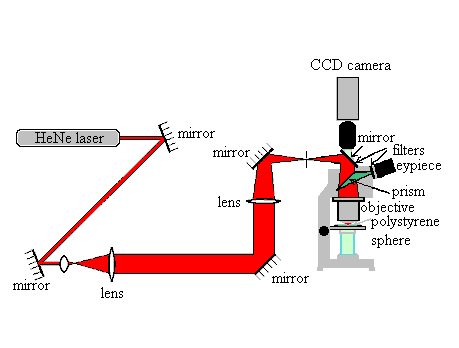Optical tweezers provide a non-invasive technique for manipulating
microscopic-sized particles. Electromagnetic waves transport energy and
momentum. When an electromagnetic wave interacts with a small particle, it
can exchange energy and momentum with the particle. The force exerted on
the particle is equal to the momentum transferred per unit time.
The force exerted by optical tweezers is on the order of pN = 10-12
N. It is too weak to manipulate macroscopic-sized objects, but it is large
enough to manipulate individual particles on a cellular level. The force is
distributed over most of the area of the particle, so fragile and delicate
objects can be manipulated without causing damage. Near-infrared laser
beams can manipulate living cells without damaging them.
In early 1970s,
Ashkin and
coworkers demonstrated that micron-sized particles could be trapped, moved and
levitated against gravity using two weakly focused laser beams. A few
years later, Ashkin demonstrated stable, three-dimensional trapping of
dielectric spheres with a single, strongly focused the laser beam. Such a
trap is called a single-beam gradient force laser trap or "optical tweezers".
It is able to capture and manipulate particles, varying in size from several
nanometers up to few tens of micrometers. A typical setup is shown in the
figure below.

A year later, Ashkin and Dziedzic used an argon-ion laser with a wavelength
of 514 nm to demonstrate that optical tweezers are capable of trapping and
manipulating living organisms. However, light of this wavelength is
strongly absorbed by bacteria and the bacteria are damaged at high power levels.
But biological cells and organisms are almost transparent to infrared light and
a Nd-YAG laser with a wavelength of 1064 nm could be used to manipulate a
variety of biological samples without damage.
Simple optical tweezers consists of a single laser beam, which is focused by an
objective lens to a diffraction-limited spot. That light then encounters a
small object that is transparent to the laser light. (Many micron sized
objects are nearly transparent to many wavelength of light. The fraction
of the incident light that they absorb is very small, since the light passes
through without interacting much.) Some laser light is
reflected from the surface of the object and
some light is transmitted. The transmitted light is not going straight through,
but is refracted (bend) as it enters and as
it leaves.

Reflection and refraction change the momentum of the incident photons and therefore transfer momentum to the sphere. The total momentum transfer per unit time or force due to all reflected photons in the beam always has a component in the direction of propagation of the beam. It is responsible for the radiation pressure. A force in this direction is called a scattering force. The total momentum transfer per unit time or force due to all refracted (bend) photons in the beam always points toward the focus of the laser beam. A force in this direction is called a gradient force. Three-dimensional trapping results when the gradient force is stronger than the scattering force. Bringing the laser beam to a tight focus produces a strong gradient force.
Look at the diagram above. The magnitude of the momentum of the photons
entering and leaving the micron-sized sphere is nearly the same, p = h/λ. But
photons leaving the sphere have a larger downward directed momentum component
than photons entering the sphere. Since momentum is conserved we have
pphoton(before) = pphoton(after) +
psphere(after),
or
psphere(after) =
pphoton(before) -
pphoton(after).
Here before and after refer to the passage of the photon through the sphere. Consider py, the vertical component of p, and let the y-axis point upward. Then py_sphere(after) is positive, since py_photon(after) is more negative than py_photon(before). The sphere moves up, towards the focus of the laser beam.
Simple optical tweezers use a single laser beam. They are easy to construct and use. Once a particle is trapped, it can be moved around in the surrounding medium without mechanical contact and without the risk of contaminating a sample which is in a closed, sterilized chamber. Optical trapping is a powerful tool. Its usefulness can be increased when optical tweezers are combined with optical scissors or scalpels for cell microsurgery. These devices consist of UV or visible laser microbeams, which are used for precision cutting and drilling of samples.
Link:
Optical tweezers (Youtube)
Chromosome
Micromanipulation (Youtube)